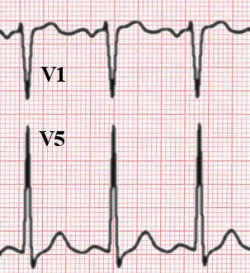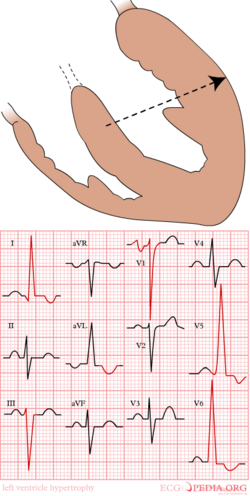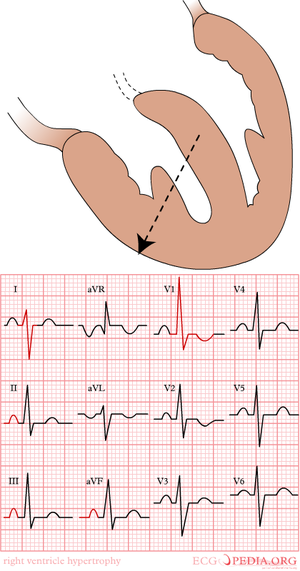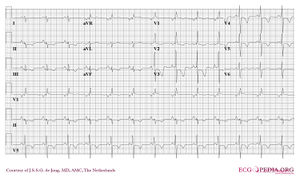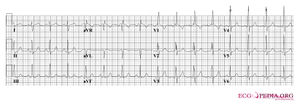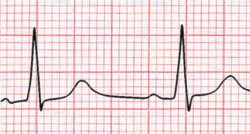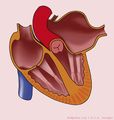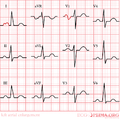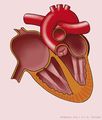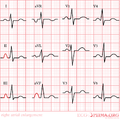Chamber Hypertrophy and Enlargment
| Author(s) | J.S.S.G. de Jong | |
| Moderator | J.S.S.G. de jong | |
| Supervisor | ||
| some notes about authorship | ||
In hypertrophy the heart muscle becomes thicker. This can have different causes. Left ventricular hypertrophy results from an increase in left ventricular workload, e.g., during hypertension or aortic valve stenosis. Right ventricular hypertrophy results from an increase in right ventricular workload, e.g., emphysema or pulmonary embolization. These causes are fundamentally different from hypertrophic obstructive cardiomyopathy (HCM), which is a congenital misalignment of cardiomyocytes, resulting in hypertrophy.
Left and right ventricular hypertrophy can be distinguished on the ECG:
Left ventricular hypertrophy
As the left ventricular wall becomes thicker, the QRS complexes become larger. This is especially true for leads V1-V6. The S wave in V1 is deep, the R wave in V4 is high. Often some ST depression can be seen in leads V5-V6, which is in this setting is called a 'strain pattern'.
To diagnose left ventricular hypertrhophy on the ECG one of the following criteria should be met: The Sokolow-Lyon criterion[1]), this is most often used:
- R in V5 or V6 + S in V1 >35 mm.
This criterion is not reliable below age 40 years.[2] In 10-29 year olds, the 99th percentile for SV1+RV5 is 53mm. In 20-39 year olds: 32% have SV2+RV5 > 35 mm.[3] Correlation between LVH on ECG and echocardiography is low with ECG having a sensitivity of 27% and specificity of 88% for echocardiographically measured LVH[4][5]. Moreover, both are independent estimators of worse prognosis.[6].
The Cornell-criterium has different values in men and women:
- R in aVL and S in V3 >28 mm in men
- R in aVL and S in V3 >20 mm in women
This is a better predicting criterium than the Sokolow-Lyon criterium, but less easy to remember, and therefore less often used.[7][8]
In the Romhilt-Estes Score LVH is likely with 4 or more points. LVH is present with 5 or more points.[9] Romhilt has reviewed ECG LVH criteria and gives an overview of the many LVH scoring systems. [10] Left ventricular hypertrophy has prognostic consequences as has been found in several studies.[7][8]
Example
Right ventricular hypertrophy
Right ventricular hypertrophy occurs mainly in lung disease or in congenital heart disease. The ECG shows a negative QRS complex in I (and thus a right heart axis) and a positive QRS complex in V1.
- QRS duration < 120ms
- Right heart axis (> 110 degrees)
- Dominant R wave:
- R/S ratio in V1 or V3R > 1, or R/S ratio in V5 or V6 <= 1
- R wave in V1 >= 7 mm
- R wave in V1 + S wave in V5 or V6 > 10.5 mm
- rSR= in V1 with R'= > 10 mm
- qR complex in V1
- Secondary ST-T changes in right precordial leads
- Right atrial abnormality
- Onset of intrinsicoid deflection in V1 between 0.035 and 0.055 s
Left atrial enlargement
- Criteria for left atrial voor left atrial enlargement. Either
- P wave with a broad (>0.04 sec or 1 small square) and deeply negative (>1 mm) terminal part in V1
- P wave duration >0.12 sec in leads I and / or II
Left atrial enlargement is often seen in mitral valve insufficiency, resulting in back flow of blood from the left ventricle to the left atrium and subsequent increased local pressure.
Right atrial enlargement
- Right atrial enlargement is defined as either
- P >2.5 mm in II / III and / or aVF
- P >1.5 mm in V1.
Right atrial enlargement can result from increased pressure in the pulmonary artery, e.g. after pulmonary embolization. A positive part of the biphasic p-wave in lead V1 larger than the negative part indicates right atrial enlargement. The width of the p wave does not change.
Biatrial enlargement
- Biatrial enlargement
- Biphasic p wave in V1 of more than 0.04 sec duration. The positive initial part is > 1.5mm and the negative terminal part > 1mm
In biatrial enlargement the ECG shows signs of both left and right atrial enlargement. In V1 the p wave has large peaks first in a positive and later in a negative direction.
References
-
Sokolow M, Lyon TP: The ventricular complex in left ventricular hypertrophy as obtained by unipolar precordial and limb leads. Am Heart J 37: 161, 1949
-
ISBN=1437711022
- Abergel E, Tase M, Menard J, and Chatellier G. Influence of obesity on the diagnostic value of electrocardiographic criteria for detecting left ventricular hypertrophy. Am J Cardiol. 1996 Apr 1;77(9):739-44. DOI:10.1016/s0002-9149(97)89209-0 |
- Levy D, Labib SB, Anderson KM, Christiansen JC, Kannel WB, and Castelli WP. Determinants of sensitivity and specificity of electrocardiographic criteria for left ventricular hypertrophy. Circulation. 1990 Mar;81(3):815-20. DOI:10.1161/01.cir.81.3.815 |
- Sundström J, Lind L, Arnlöv J, Zethelius B, Andrén B, and Lithell HO. Echocardiographic and electrocardiographic diagnoses of left ventricular hypertrophy predict mortality independently of each other in a population of elderly men. Circulation. 2001 May 15;103(19):2346-51. DOI:10.1161/01.cir.103.19.2346 |
- Sundström J, Lind L, Arnlöv J, Zethelius B, Andrén B, and Lithell HO. Echocardiographic and electrocardiographic diagnoses of left ventricular hypertrophy predict mortality independently of each other in a population of elderly men. Circulation. 2001 May 15;103(19):2346-51. DOI:10.1161/01.cir.103.19.2346 |
- Levy D, Salomon M, D'Agostino RB, Belanger AJ, and Kannel WB. Prognostic implications of baseline electrocardiographic features and their serial changes in subjects with left ventricular hypertrophy. Circulation. 1994 Oct;90(4):1786-93. DOI:10.1161/01.cir.90.4.1786 |
- Romhilt DW and Estes EH Jr. A point-score system for the ECG diagnosis of left ventricular hypertrophy. Am Heart J. 1968 Jun;75(6):752-8. DOI:10.1016/0002-8703(68)90035-5 |
- Romhilt DW, Bove KE, Norris RJ, Conyers E, Conradi S, Rowlands DT, and Scott RC. A critical appraisal of the electrocardiographic criteria for the diagnosis of left ventricular hypertrophy. Circulation. 1969 Aug;40(2):185-95. DOI:10.1161/01.cir.40.2.185 |
